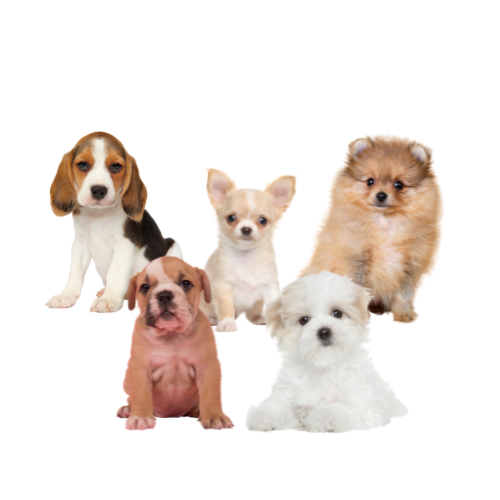Any dog, whether large or small, long-haired or short, needs regular grooming to prevent health problems with its skin, ears, mouth, nails, and eyes. Getting your dog used to grooming from puppyhood will prevent stress throughout its life.
Many dogs have a hard time being handled and, as a result, become very difficult to manage. This is a very common problem.
The result is a lack of care, the only solution being to leave them in the hands of professionals who are forced to subject them to highly stressful grooming sessions, both for the dogs themselves and for the dogs themselves.

STARTING AT HOME
Start from a very young age with short grooming sessions, five minutes, and gradually increase them over time as you get your puppy to relax while you groom him.
It's always helpful and much easier to handle the task if you do it on a raised, stable surface. A grooming table is suitable for puppies and small or medium-sized dogs, and a bench is suitable for larger dogs.
Before picking him up for the first time, let him be the one to ask for contact. Crouch down, get down to his level, and wait until he really wants to get on you. If he climbs onto your knee, you've already made a lot of progress. Then, hold him gently and firmly. After the walk or playtime, your puppy will be more tired and will find it easier to relax.
- Puppy handling should be done with " calmness and patience ," but with " firmness ." Do not allow submissive behavior, escape attempts, or even biting. During the first few grooming sessions, you can divert your puppy's attention by providing something to distract him. Demonstrate absolute control of the situation from the very beginning.
- Brush gently with a flexible brush or carder .
- Clean your eyes by removing tears, if necessary, with gauze and a cleansing liquid.
- Check the pads and the spaces between the toes; they should be clean and free of foreign objects. This is a particularly delicate area; wait until your dog is accustomed to contact in less sensitive areas. If the pads are dry, apply moisturizing cream .
- If the baby has drool, urine, or feces on it, wipe it with a wet wipe or absorbent cloth.
By doing this daily, it will soon become part of your routine, and before you know it, you'll make him eager to get up on the table to enjoy your special moment of attention.

The first bath can be given shortly after acquiring the puppy, always making sure it's properly vaccinated and dewormed. You can wait a day or two to give it time to settle into its new home, once you've confirmed that the puppy is completely relaxed.
Have everything you need ready before starting any session, including the shampoo solution in warm water. Have everything you'll need on hand to avoid taking risks by letting your dog out of your control, especially during the first few sessions.
In the bath, you'll need to control the temperature of the water and the room so your puppy doesn't get cold at all. After bathing, dry him with a towel and blow dry him with warm air until he's completely dry.
A puppy's coat is different from what it will be as an adult. It's softer and finer. Their skin is also more sensitive. Bathe them with a nourishing shampoo. and don't forget to apply a good conditioner to keep your skin and hair well hydrated.
In reality, it doesn't need to be a specific shampoo for puppies, although it is important that it be a good, nourishing cosmetic.
As the puppy approaches adulthood, the coat may vary in texture and color, in which case it will need to be treated according to the coat type.

Recommendation by hair type
-
If it is short-haired: Dalmatian type, Bulldog.
Continue with the nourishing and revitalizing shampoo and conditioner to maintain optimal hydration, bathing every 15 to 20 days. -
If you have fine, long hair: Yorkshire, Maltese, Shih-Tzu type.
This type of nourishing shampoo and conditioner is also ideal. Also, spray a conditioning spray. Before daily brushing, it should be used to keep your dog protected from external aggressions. The length of your dog's coat determines the frequency of bathing. These types of dogs, kept "hairless," are bathed weekly. -
If it is a coat with volume: Pomeranian type, Nordic, poodle.
Use a nourishing shampoo and conditioner for maintenance baths, and if you want a full-bodied finish for a one-off event, replace the conditioner with a volumizing spray or mousse. .
The frequency of bathing for this type of dog is 15-20 days. -
If it is wire-haired: Most Terriers, Schnauzers, Griffons.
Use a nourishing shampoo and conditioner for maintenance baths, and if you want to maintain the hard texture for a one-off event, bathe with a texturizing shampoo.special for hard hair and do not apply conditioner.
The frequency of bathing for this type of dog is more complicated.
The dog's body area is usually shorter and less prone to dirt. Washing it every 20 days is sufficient. However, many wire-haired breeds have areas such as the skirts, legs, heads, or beards with long hair that require more frequent bathing. To care for these areas, it is advisable to bathe them weekly with nourishing shampoo and conditioner. Keep a good conditioning spray on hand. for brushing.

0 comments